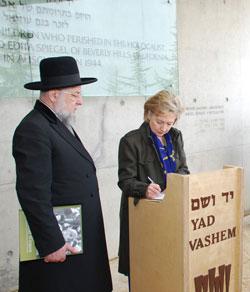
Secretary Clinton views the Bruno Schulz: Wall Painting under Coercion display in the Holocaust Art Museum at Yad Vashem today

Rabbi Israel Meir Lau, Chairman of the Yad Vashem Council, presents Secretary Clinton with To Bear Witness, a book about Yad Vashem, at the conclusion of her visit today

Secretary Clinton signs the Yad Vashem Guest Book at the Exit to the Children's Memorial at the end of her visit today. Rabbi Israel Meir Lau, Chairman of the Yad Vashem Council is at her side
03 March 2009
US Secretary of State Hillary Clinton visited Yad Vashem today, Tuesday, March 3, 2009. She was accompanied by Chairman of the Yad Vashem Council Rabbi Israel Meir Lau. The Secretary visited the new Bruno Schulz display, Wall Painting under Coercion, in the Holocaust Art Museum, guided by Director of the Museums Division Yehudit Inbar and Senior Art Curator Yehudit Shendar. Following the visit to the Holocaust Art Museum, the Secretary participated in a Memorial Ceremony in the Hall of Remembrance, visited the Children’s Memorial, and signed the Yad Vashem Guest Book.
"Yad Vashem is a testament to the power of truth in the face of denial, the resilience of the human spirit in the face of despair, the triumph of the Jewish people over murder and destruction and a reminder to all people that the lessons of the Holocaust must never be forgotten. God bless Israel and its future. Hillary Rodham Clinton March 3, 2009," wrote the Secretary in the Guest Book.
About the Bruno Schulz display in the Holocaust Art Museum at Yad Vashem:
Wall Painting under Coercion includes three original wall paintings, the last known work of Bruno Schulz before his murder at the hands of an SS man on November 19, 1942, as well as other works by and information about the writer and artist.
Bruno Schulz was born in Drohobycz (then Poland, today Ukraine). A Jewish author and artist, he was forced to embellish the walls of the nursery in a house occupied by S.S. man Felix Landau with fairy-tale protagonists. He was later shot to death by an SS sergeant on a day of pogroms in the city of Drohobycz. Despite being forced to paint the room by a brutal slave master, Schulz managed to maintain his distinctive artistic style, and his trademark inclusion of self-portraits in the works.
Some 60 years after they were made, the works were discovered in a state of neglect and disrepair. Since their arrival at Yad Vashem, they have undergone professional conservation to ensure that no further deterioration of the materials and colors occurs in the future. The paintings are on long-term loan from the Drohobychyna Museum, Ukraine.






